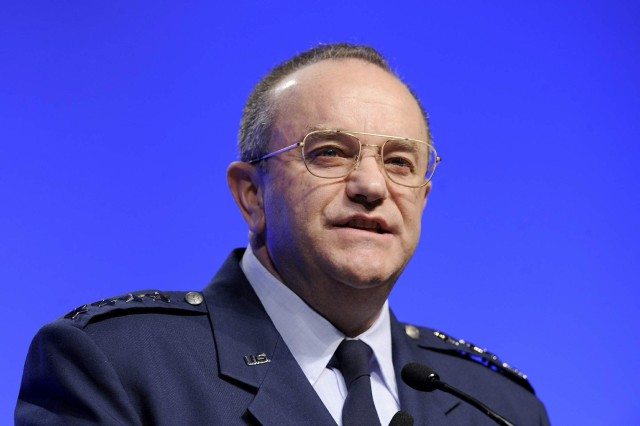The Air Force is working to balance today’s needs and tomorrow’s challenges while operating under intense fiscal pressures, the service’s vice chief of staff said here Feb. 17.
During remarks at the Air Force Association’s 2011 Air Warfare Symposium and Technology Exposition, Gen. Philip M. Breedlove said the Air Force must remain committed to the joint and coalition team, adaptable to an ever-changing battlefield, and keener about acquisition in response to a more restrained budget.
“Our nation demands and relies on us to fight across the full spectrum of conflict, not just the wars we find ourselves in today,” General Breedlove said. “We face static or even declining real budgets, and certainly decreased purchasing power, yet we have to be prepared across the entire spectrum of operations.”
The general said that this task will be increasingly daunting as previous permissive budget environments, which enabled the Air Force to buy advanced weapons systems and capabilities, become a thing of the past.
To better prepare for financial and battlefield uncertainties, he said the Air Force must apply irregular warfare lessons learned, normalize the career fields most strained by today’s fight, and recapitalize its most stressed platforms.
“We’ve ramped up remotely piloted vehicle orbits from one in 2001 to 48 today,” General Breedlove said. “We’ve given eyes to the ground commander that they never anticipated, and eyes that they cannot now live without.”
General Breedlove said remotely piloted aircraft and other platforms supporting the joint and coalition team overseas are so critical to the current fight that they have been at surge rates for years.
“Our remotely piloted aircraft operators have had assignments extended, leaves canceled, and test and training sorties foregone in order to fly and fill our combat requirements,” the general said. “We’ll need to incorporate these capabilities to a more normalized air expeditionary force structure, one that brings more predictability to our Airmen’s lives.”
General Breedlove lauded the “inherent flexibility and adaptability” of airpower and Airmen, as seen in today’s irregular warfare.
“They have repeatedly proven invaluable in our wars in both Afghanistan and Iraq,” the general said. “They’ve helped develop vital airlift, precise air drop, refueling capabilities and, most importantly, they have ensured many other tactical and operational accomplishments that have direct effect on our strategic goal in Afghanistan.”
Airmen have shown this innovation in the face of an incredibly high operations tempo, which has also taken a toll on the Air Force’s aircraft, the general said.
“With an eye toward the long term viability of our tactical forces, we will ensure that our current fighters are fully mission-capable long from now as the F-35 (Lightening II) comes on line,” General Breedlove said. “We’re outfitting the service’s F-15 (Eagle) fleet with new radars and investigating extending the service life of our F-16 (Fighting Falcons).”
While the Air Force continues to support today’s fight, the service must also be ready to deter and defeat others who may impede the interests of the U.S. and its partners, the general said.
“There are potential adversaries who are currently developing capabilities and strategies that can test our ability to operate in those global commons around the world, key regions where some of our most vital national interests lie,” the general explained.
As a result, officials continue to develop a force that can contend with anti-access and area-denial, or A2AD, environments, General Breedlove said. One such example is the Air Force’s collaborative efforts with the Navy and Marine Corps on the Air-Sea Battle concept.
“In the past, we’ve succeed by using temporary and sometimes ad hoc arrangements where our air and naval components have collaborated,” the general said. “Lacking an institutional underpinning, these institutional arrangements have not evolved.”
Service leaders hope to remedy this through Air-Sea Battle, which will create an enduring partnership between the nation’s air and sea services, General Breedlove said.
In addition to concepts like Air-Sea Battle, new platforms like the long range strike bomber will further help the Air Force contend with A2AD environments, the general said.
However, development of the system will differ from past procurements, he said.
“It will not be a vast and prohibitively expensive acquisition program,” he added. “Long range strike will improve upon the capability that our nation already has and will balance weapons integration, new electronic warfare techniques, and penetrating intelligence, surveillance and reconnaissance.”
Underpinning Air Force efforts across the full spectrum of operations are the critical capabilities provided by U.S. space systems, General Breedlove said.
To ensure the U.S. continues to have these important capabilities, the general said the Air Force is looking to end the current practice of purchasing satellites one at a time or on a just-in-time basis, which has resulted in debilitating cost increases.
“These short-sighted acquisition strategies have caused production line breaks, parts obsolescence and inefficient use of labor, all of which have raised the cost of our satellite systems, reduced the number of spacecraft we can procure, and contributed to the fragility of our space industrial base,” General Breedlove said.
To remedy these acquisition fissures, the general cited a new acquisition strategy for buying military space systems called evolutionary acquisition for space efficiency, or EASE.
“Through EASE and with the support of Congress, we will propose block purchases of satellites, fixed-price contracts, stable research and development, and modified annual funding to cover the systems,” the general said.
The general expressed confidence in the Air Force’s ability to achieve new levels of efficiency and effectiveness across its mission set by working together with the private sector.
“Perhaps now more than ever before, we depend on each other,” General Breedlove said. “I am sure that working together, we can end up playing a winning hand, no matter which cards we have been dealt.”










